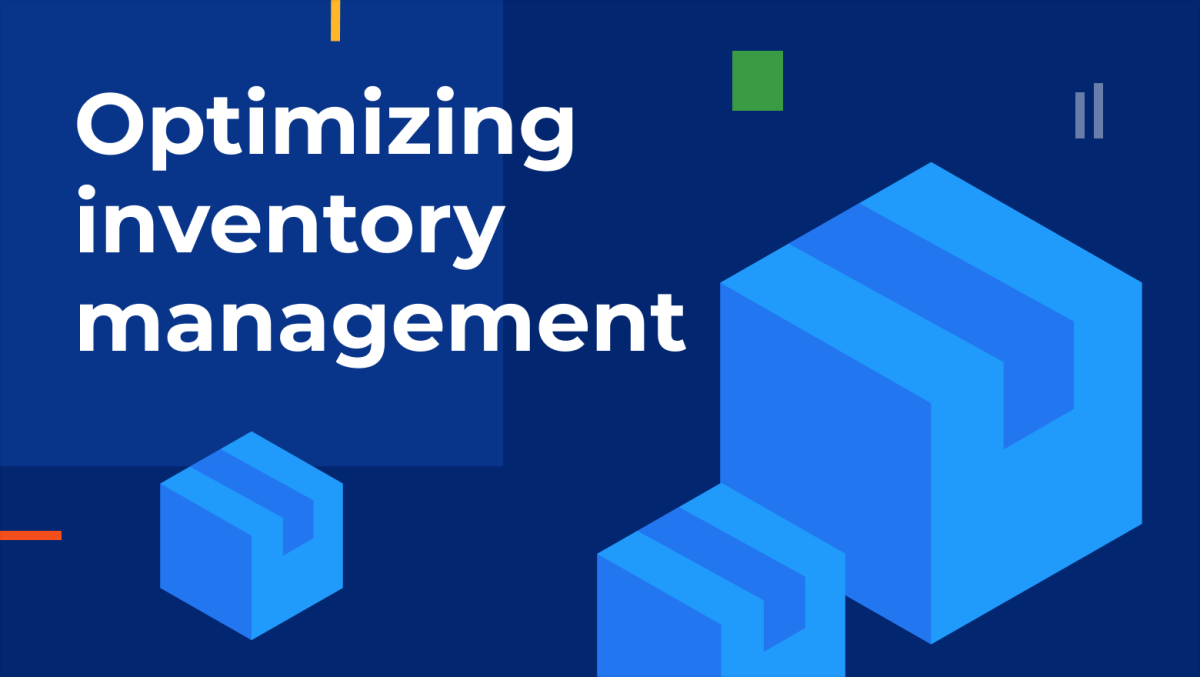Effective inventory management is crucial for the success of any Amazon seller’s business. Failure to consistently optimize inventory can lead to increased operating costs and, ultimately, reduced profitability.
In this article, we’ll look closely at Amazon inventory management and discuss the best practices sellers can follow to optimize their inventory levels and maximize their profits.
A healthy Inventory Performance Index (IPI) score will reduce your operating costs
Amazon utilizes the Inventory Performance Index (IPI) as a metric to assess and evaluate sellers’ effectiveness to manage their FBA inventory. The IPI is designed to optimize inventory levels and improve overall operational efficiency within Amazon’s fulfillment network.
There are several reasons why Amazon uses the IPI:
- Optimal Use of Fulfillment Center Capacity: Amazon operates numerous fulfillment centers worldwide to store and ship products on behalf of sellers. To ensure efficient utilization of these centers, Amazon must manage inventory effectively. The IPI score allows Amazon to identify sellers who are effectively managing their inventory and reward them with additional storage capacity.
- Reduction of Storage Costs: By encouraging sellers to maintain healthy inventory levels, Amazon can reduce their storage costs. Excessive inventory ties up warehouse space and increases storage fees for both Amazon and sellers. By using the IPI to incentivize sellers to optimize their inventory, Amazon can lower its own costs and create a more profitable fulfillment network.
- Enhancing Customer Experience: Amazon strives to provide fast and reliable shipping to its customers. Sellers with a higher IPI score are given priority for the Two-Day Shipping program, which ensures faster delivery to customers. By prioritizing sellers with better inventory management practices, Amazon can enhance the overall customer experience and satisfaction.
- Promoting Seller Success: Amazon wants its sellers to succeed and thrive on its platform. By providing sellers with insights into their inventory management performance through the IPI score, Amazon helps them identify areas for improvement. Sellers can use this information to optimize their inventory levels, minimize stockouts, and maximize sales potential, leading to increased profitability.
Overall, the Inventory Performance Index is a tool that Amazon uses to encourage sellers to adopt best practices in inventory management. It benefits Amazon by optimizing warehouse capacity and reducing costs while promoting a positive customer experience and enabling seller success.
? An IPI score above 400 will benefit your business:
- grant you additional storage capacity in Amazon fulfillment centers;
- lower your storage costs;
- increase the number of products you can sell on Amazon with two-day shipping.
How to increase your IPI score
- Maintain Adequate Stock Levels
Ensure that you have enough inventory to meet customer demand without excessive overstocking. Strive to strike a balance between having sufficient stock to fulfill orders promptly and minimizing excess inventory. Regularly monitor your sales data, seasonal trends, and customer demand to make informed inventory replenishment decisions. - Avoid Stockouts
Stockouts occur when you run out of inventory for a particular product. They can negatively impact your IPI score. Implement inventory forecasting techniques to anticipate demand accurately and restock your inventory promptly. Utilize tools such as sales data analysis, historical trends, and predictive analytics to forecast demand and avoid stockouts. - Optimize Inventory Performance
Improve your inventory turnover rate by focusing on products with higher demand and reducing inventory holding periods. Identify slow-moving or low-demand products and consider strategies such as pricing adjustments, promotions, or bundling to increase their sales velocity and reduce their storage time. - Minimize Excess and Long-Term Storage
Excessive inventory or inventory that remains in Amazon’s fulfillment centers for an extended period can negatively impact your IPI score. Regularly review your inventory and identify products that are not selling well. Consider reducing prices, running promotions, or using other strategies to move stagnant inventory and avoid long-term storage fees. - Improve Inventory Accuracy
Maintain accurate inventory records by regularly updating product listings, quantities, and variations. Precise inventory management reduces the risk of overselling or mismatched inventory, which can lead to negative customer experiences. Utilize inventory management software or Amazon’s inventory management tools to ensure real-time inventory accuracy. - Optimize Product Listing Quality
Ensure your product listings are accurate, complete, and optimized for search. High-quality listings can lead to increased sales velocity and improved customer satisfaction. Pay attention to product titles, descriptions, images, and relevant keywords to attract potential customers and drive conversions. - Streamline Operations and Shipping
Efficiently manage your order fulfillment and shipping processes to minimize delays and errors. Aim for fast order processing and timely shipment of products to customers. Utilize Amazon’s FBA (Fulfillment by Amazon) services for reliable and prompt order fulfillment. - Monitor and Act on IPI Insights
Regularly check your IPI score and the associated insights provided by Amazon. They provide guidance on areas where you can improve your inventory management practices. Use this information to identify potential areas of concern and take appropriate actions to address them.
Understand your inventory management risks
You may encounter inventory issues at some point. However, these issues are a normal part of selling on Amazon and should be treated as something that can and should be managed, rather than a critical risk to your business.
Let’s take a look at the most common types of inventory issues that Amazon sellers run into.
- Out of Stock risks
Many Amazon sellers face stockouts due to insufficient inventory management practices, such as inaccurate demand forecasting, underestimating lead times, and inadequate inventory ordering.
Furthermore, unforeseen events like supply chain disruptions or sudden surges in demand can also result in stockouts. Such occurrences can adversely affect a seller’s sales, rankings, and customer confidence. If you find yourself with no inventory, you may encounter the following risks.
| Risk | Effect |
|---|---|
| Lost sales and lost profits | This is the most obvious and immediate effect of a stockout. |
| BSR and keyword rank drop | A stockout can cause a drop in BSR, which can negatively impact a product’s visibility and search ranking on Amazon, ultimately leading to a decrease in sales. |
| Sponsored product ads get disqualified | When an ad is disqualified due to a stockout, it may also impact its overall performance and effectiveness once it is back up and running. The ad may need to go through a “learning period” again as it gathers data on the new inventory levels and customer demand. This can lead to a temporary decrease in the ad’s performance, which may result in lost sales and revenue. |
| SEO is affected | When a product goes out of stock on Amazon, it can harm its search engine optimization (SEO) both on and outside Amazon (e.g., on Google). This is because search algorithms typically consider various metrics to determine a product’s relevance and popularity among shoppers. One of these metrics is sales velocity, which measures how quickly a product sells. When a product is out of stock, it can no longer generate sales, lowering its sales velocity. This can lead to a drop in its search ranking as Amazon’s algorithm will assume that the product is less popular or less relevant to shoppers. |
| The Buy Box is lost | When a seller loses the buy box on Amazon due to a stockout, the seller is temporarily out of stock, and Amazon has temporarily removed their listing from the “Buy Box” section. Instead, other sellers who have the item in stock will appear in the Buy Box section, and the seller who is out of stock will appear further down the page. Losing the Buy Box can be a serious issue for sellers, as the Buy Box is a highly visible and prominent section on Amazon’s product pages. Winning the Buy Box can significantly increase sales. Losing the Buy Box due to a stockout can result in a drop in sales and negatively impact a seller’s overall Amazon performance metrics. |
- Excess inventory risks
Overstock is a common problem that Amazon sellers face that can pose a significant risk to their businesses. Holding excess inventory ties up valuable capital and warehouse space, leading to increased storage fees, decreased cash flow, and even reduced profitability.
In addition, overstocked products may become obsolete or lose their appeal, which can result in a loss of sales and revenue.
| Risk | Effect |
|---|---|
| Increased storage fees | Additional storage fees for inventory that remains in their warehouses for more than 365 days. If you have excess inventory, you will start losing profits. The fees are charged per cubic foot of space and increase significantly after 365 days. Higher fees for storage from October to December, which is when they experience the highest demand. If you have a lot of slow-moving inventory during this period, you may pay more in storage fees than you would if you had sold the inventory earlier in the year. |
| Reduced cash flow | Excess inventory ties up your cash flow and prevents you from investing in other areas of your business. If you have too much inventory that is not selling, you may need help paying bills or purchasing new inventory. |
| Increased competition | If your excess inventory is not selling, you may need to reduce your prices to move it. This can lead to increased competition with other sellers who are also lowering their prices, potentially driving down your profits even further. |
8 tips to optimize inventory management
Effective inventory management involves ensuring that the right products are in stock at the right time to meet customer demand. In the following, we’ll cover eight tips to optimize your Amazon inventory management.
- Create enduring partnerships with your suppliers.
Suppliers play a vital role in the success of your business and you can also aid their business growth. To maintain healthy relationships with your suppliers, pay your bills on time, treat them respectfully, communicate regularly and constructively, and build goodwill by referring business.
Positive interactions with the key players in your supply chain not only ensure that you receive the right products on time but also assist you in anticipating any manufacturing or shipment issues and keep track of lead times to avoid stockouts or overstocking
Lead time – is the time it takes for a product to be manufactured and delivered to Amazon’s warehouse.
Keep a close eye on supplier lead times and factor them into your restocking schedule. If lead times become longer than usual, adjust your ordering cycle accordingly to prevent stockouts.
?How sellerboard can help:
- track your lead times
- know exactly when to reorder
- estimate the number of “Days of stock left” and “Days until next order” for each product
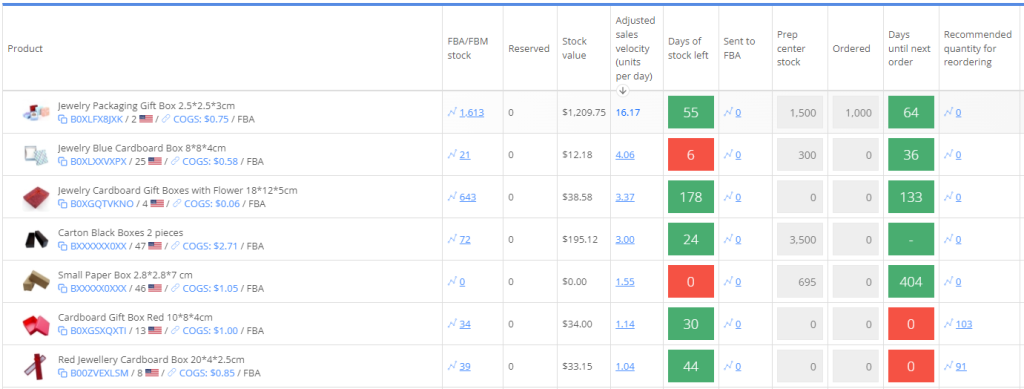
- Monitor your sell-through rate.
Your FBA sell-through rate refers to the number of products you sell in relation to your stock. The goal is to maintain an optimal balance between the amount of inventory you receive and the amount you sell.
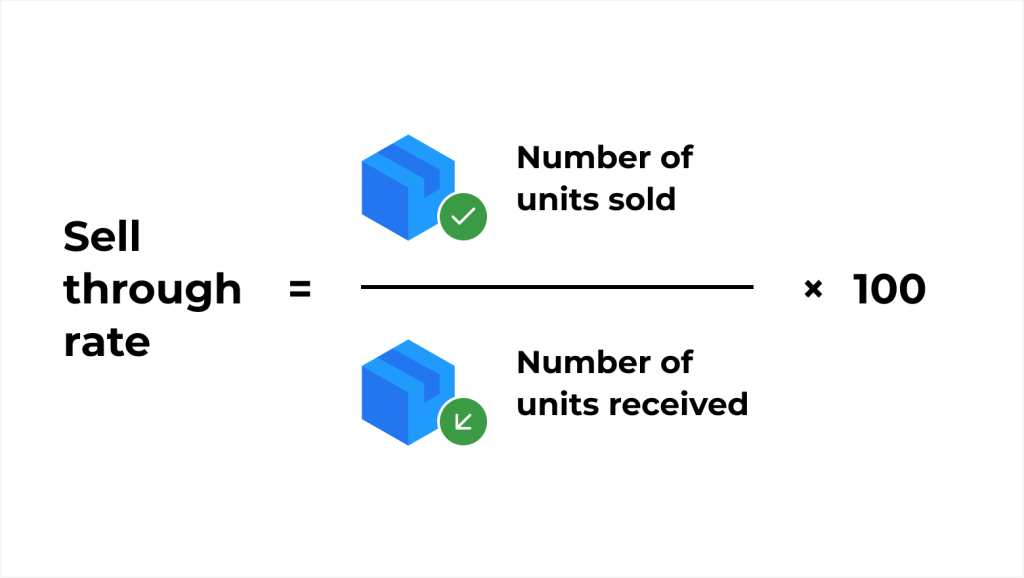
The optimal sell-through rate for an Amazon seller can vary depending on various factors, such as the product category, seasonality, and competition. In general, a healthy sell-through rate is around 10-20%. This means that you consistently sell a significant portion of your inventory within a given period. However, it’s important to note that the ideal sell-through rate can differ based on individual business goals and circumstances. Monitoring your sell-through rate and comparing it to industry benchmarks can help you gauge the performance of your inventory management and make necessary adjustments to optimize your sales.
To achieve this balance, use sales forecasting methods or review past order quantities to estimate demand accurately.
?How sellerboard can help:
- Estimate demand accurately by analyzing your product sales trends;
- Provide a comprehensive picture for any individual product including the sales history, as well as any other KPIs of your choice.
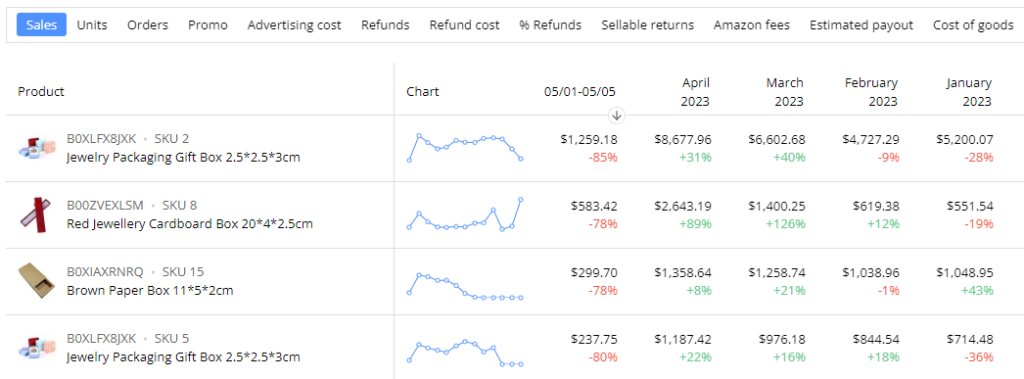
- Quickly restock popular products.
To meet customer demand while avoiding excessive storage costs, it’s vital to closely monitor your sales and plan accordingly. You can anticipate your inventory needs throughout the year by using sales forecasting methods and analyzing historical data.
It’s also helpful to monitor the days of supply for your top-selling products and replenish your stock promptly. This will prevent lost sales and improve profitability and growth potential by keeping popular products in stock.
Here are some tips to help you expedite the restocking process:
? Set up inventory alerts: Utilize inventory management tools or Amazon’s replenishment alerts to receive notifications when your stock levels reach a certain threshold. This allows you to proactively restock before running out.
? Forecast demand accurately: Analyze sales data, market trends, and seasonality patterns to forecast the demand for your popular products. This enables you to anticipate restocking needs and place orders on time.
? Consider FBA (Fulfillment by Amazon): Utilizing Amazon’s FBA service can expedite restocking. By sending your inventory to Amazon’s fulfillment centers in advance, you can benefit from their fast shipping and efficient order processing.
? Implement just-in-time inventory management: Adopt a lean inventory management approach where you order inventory to arrive just in time to meet demand. This helps minimize excess stock while ensuring you have enough to fulfill orders promptly.
? Expedite shipping methods: If possible, explore expedited shipping options offered by your suppliers or freight forwarders. This can reduce transit times and accelerate the restocking process.
By implementing these strategies, you can restock popular products quickly and efficiently, ensuring a steady supply to meet customer demand and maximize your sales potential on Amazon.
?How sellerboard can help:
- Set up automated inventory alerts.
- Calculate adjusted sales velocity;
- Forecast reorder times;
- Account for seasonality and projected monthly growth;
The adjusted sales velocity is the average number of units sold per day. This number is adjusted by the “weight” entered per period.
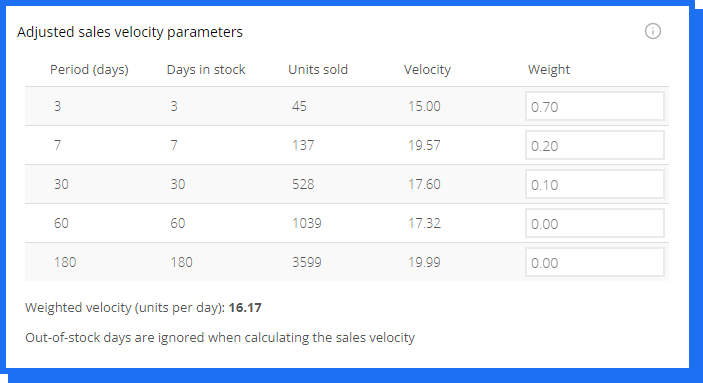
Seasonality refers to fluctuations in your sales caused by external factors and occur on a predictable schedule around the same time every year. If you turn on this option, your future sales will be forecasted, taking into account the specified coefficients. You can use sellerboard default coefficients or change them based on your experience.
Additionally, you can project a monthly growth rate in %, which will also be included in the forecast.

- Keep an eye on your margins.
Maintaining healthy sales margins is a crucial indicator of a business’s success. To ensure that your profits are in good health, you must track all your operating costs, fees, and indirect expenses.
While Amazon Seller Central provides tools and reports to track your direct fees and some indirect expenses, it may only cover some of them comprehensively.
Within Seller Central, you can access reports that provide insights into your direct fees, such as referral fees, fulfillment fees, and advertising costs. These reports help you understand the costs directly associated with selling on Amazon.
However, when tracking indirect expenses, such as marketing expenses, software subscriptions, packaging materials, or other operational costs that Amazon does not directly charge, Seller Central may not offer specific tools or reports.
To effectively track and manage these indirect expenses, it is recommended to utilize external accounting software or spreadsheets. By integrating your Amazon sales data with your accounting system, you can keep a detailed record of all expenses associated with your Amazon business, including both direct fees and indirect expenses.
?How sellerboard can help:
- View a complete picture of all factors that affect profit margins;
- Manage cost of goods by batch, period or marketplace;
- Account for one-time and recurring indirect expenses.
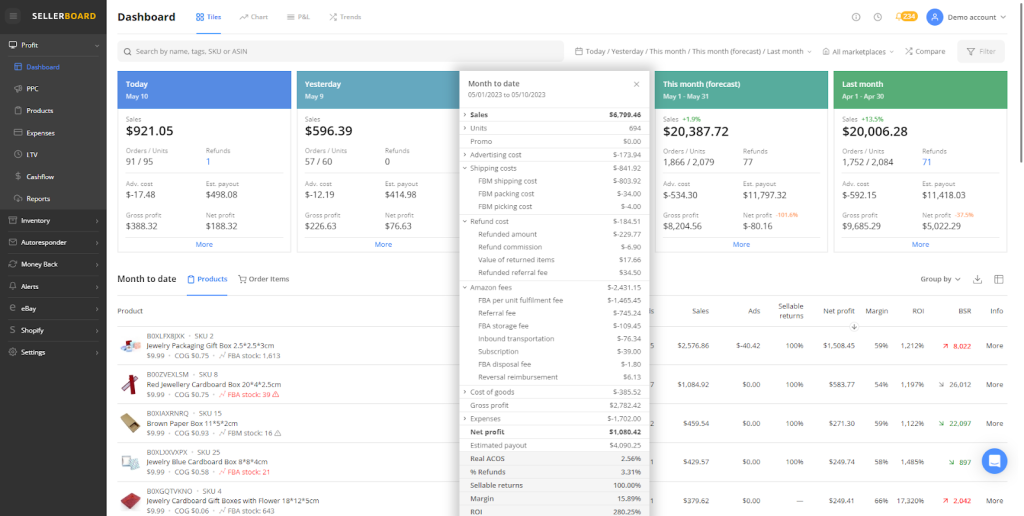
- Plan for the unexpected (analyze and forecast).
Sometimes Amazon sellers face obstacles that can disrupt the smooth flow of operations. For instance, you may encounter issues such as supplier delays, shipping delays, customs delays, and FBA warehouse delays.
The COVID pandemic serves as a perfect example of such disruptions, as it resulted in manufacturing and supply chain disruptions that made it difficult for 53% of U.S. consumers to find products online starting March 2020.
To mitigate such issues, it’s advisable to order backup units in case something happens along your supply chain. You can store extra units in your warehouse or use a third-party storage/fulfillment center. This will help you maintain stock in FBA without worry, or even fulfill orders using FBM if there’s a delay.
However, it’s important to note that this strategy is only recommended if you can accurately predict the demand for your product and order and store additional units. You shouldn’t order extra units if you’re short on capital or storage space.
?How sellerboard can help:
- Create a FBA buffer. When calculating the time to reorder and the recommended amount to reorder, sellerboard will ensure your stock doesn’t fall below this buffer.

- Reduce aging and excess inventory to increase your profitability.
Mark down products or create special deals to liquidate aging inventory or overstock products. While you may be selling products for less than you predicted, this will help you avoid the sunk costs of continuing to stock the products in your storage facility.
?️ Some ideas of special deals that might help you start:
- Run promotions;
- Use coupon codes;
- Try buy-one-get-one deals;
- Offer steep discounts.
?️ Lowering your price is an effective way to accelerate sales for slow-moving inventory. While you may take a slight loss in the sale price, it could be less than what you would owe in long-term storage fees if the units continue to sit in storage.
☝️ Raise your keyword bids if you are running ads for your products. By targeting specific keywords, you can increase your chances of reaching more customers and moving the product. This strategy, combined with lowering your price, is a surefire way to move stale inventory.
↩️ Creating a removal order is also an option if you have another place to store inventory other than Amazon. You can do this by creating a removal order in Seller Central and having the inventory sent to you before getting hit with large storage fees. Amazon may also run promotions where they will remove the inventory for free.
❌ Liquidation is usually a last resort, but if all other efforts fail, you can try to sell your remaining inventory in bulk at a large discount. This will allow you to regain some capital that can be reinvested into a better-selling product.
? Another option is to donate the inventory to charity organizations or non-profits such as Goodwill. You can often write off the donated inventory on your taxes to compensate for the losses.
No matter what strategy you choose, it’s essential to take action to move your excess inventory. This will free up space in your warehouse and help avoid unnecessary storage fees, keeping your business healthy and profitable.
?How sellerboard can help:
- Optimize PPC bidding to reach a higher ACoS
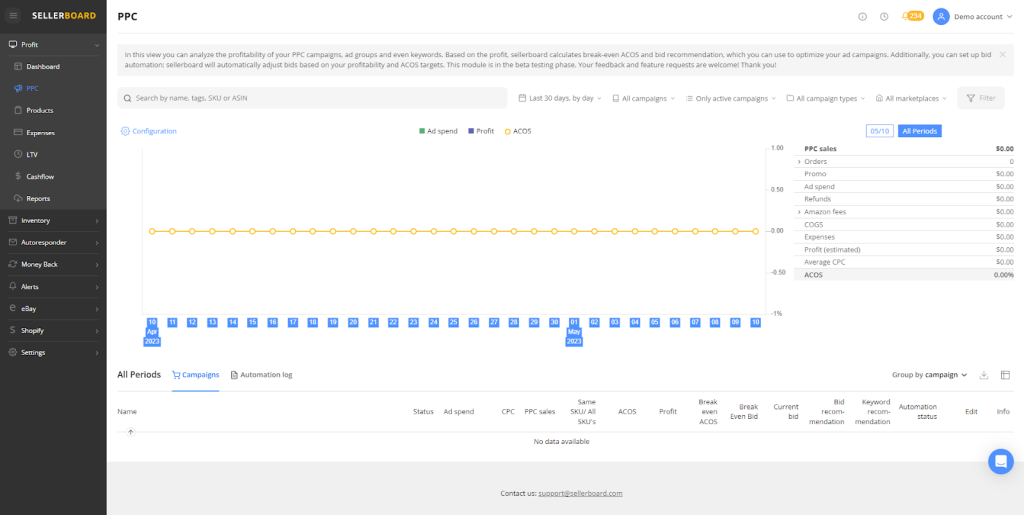
- Lower the demand if you are running low on inventory.
To maintain your in-stock rate and improve your IPI score, consider raising the price and temporarily pausing advertising campaigns if you are running low on inventory. This will help manage the demand and prevent running out of stock, which can negatively impact your rankings and sales. It is better to slow down sales slightly than completely run out of stock.
Once you replenish your FBA inventory to a healthy level, you can resume your normal price points and advertising campaigns to drive sales.
| ⚠️ It is generally advisable not to pause your campaigns since Amazon tends to favor keywords and campaigns that run consistently over a longer duration rather than shorter periods. |
- Choose the right inventory management system.
Here are some key considerations to help you make the right choice:
? Scalability: Ensure that the system can accommodate your growing business needs and handle increasing inventory volumes.
? Integration: Look for a system that seamlessly integrates with Amazon Seller Central and other essential tools you use for inventory management, such as order management systems or shipping software.
⚙️ Automation: Consider a system that offers automation features like inventory tracking, replenishment alerts, and order synchronization to streamline your operations and minimize manual tasks.
? Live data: Look for a system that provides real-time visibility into your inventory levels, sales, and other crucial metrics, allowing you to make informed decisions.
? Forecasting capabilities: Find a system that offers robust demand forecasting features to help you predict future inventory needs accurately and avoid stockouts or overstocking.
? Reporting and analytics: Choose a system that provides comprehensive reporting and analytics tools to gain insights into your inventory performance, sales trends, and profitability.
? User-friendly interface: Consider a system that is easy to navigate and user-friendly, as it will save you time and reduce the learning curve for you and your team.
By carefully evaluating these factors and understanding your specific inventory management requirements, you can select an inventory management system that best fits your business needs on Amazon.
?How sellerboard can help:
First, it offers scalability, allowing sellers to handle their growing inventory volumes effortlessly. Secondly, it seamlessly integrates with sellers’ Amazon accounts, ensuring a seamless flow of data. Moreover, sellerboard’s inventory module provides powerful automation features such as inventory tracking, replenishment alerts, and purchase order management, reducing manual efforts and saving time.
Additionally, the Inventory module offers robust sales forecasting capabilities and provides reorder quantity recommendations, allowing sellers to avoid stockouts and overstocking. Lastly, it delivers in-depth profit and inventory analytics, empowering sellers to make informed decisions based on comprehensive data.
If you would like to learn more about the sellerboard Inventory module, check out these instructional videos:
Key takeaways
- Effective inventory management is essential for Amazon sellers to increase profitability;
- By optimizing inventory levels and implementing best practices, sellers can mitigate risks and maximize their profits;
- Maintaining a healthy Inventory Performance Index (IPI) score is crucial because it can lead to additional storage capacity, lower storage costs, and increased sales opportunities;
- Sellers should focus on replenishing popular products, maintaining healthy inventory levels, and fixing listing problems to improve their IPI score;
- Inventory issues such as stockouts and excess inventory can negatively impact sales, rankings, and customer confidence;
- To optimize inventory management, sellers can follow eight key tips, including building strong supplier relationships, monitoring sell-through rates, restocking popular products quickly, tracking margins, planning for unexpected disruptions, reducing aging and excess inventory, and adjusting demand when running low on inventory;
- Choosing the right inventory management system is also critical for scalability and integration;
- By implementing these strategies and utilizing tools like sellerboard, Amazon sellers can enhance their inventory management practices and increase profitability in their businesses.
